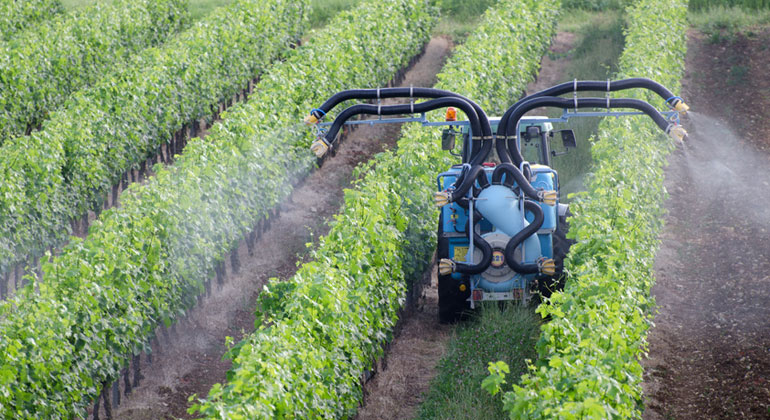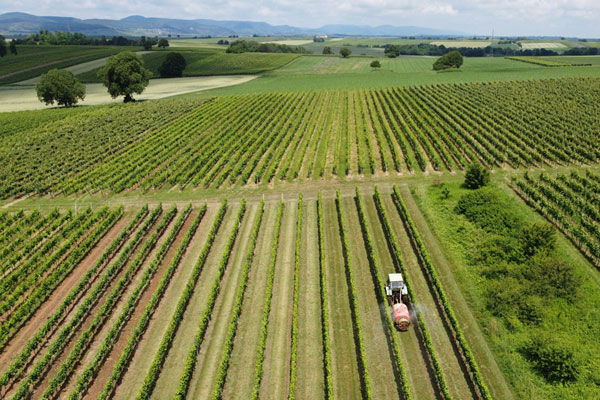pesticide mixtures are present in soil and plants all year round
In conventional agriculture, synthetic chemical pesticides are used in various crops such as arable farming, vegetable growing and viticulture. A study by the RPTU University Kaiserslautern-Landau, recently published in the journal “Scientific Reports”, is the first to examine pesticide contamination over the course of a year. It shows that substances can be detected not only during the spraying periods in the fields, but also throughout the year and in adjacent meadows. The impact of these chronically detected complex pesticide mixtures on the environment has not been sufficiently investigated and could be significant.
In Germany, crops are grown on more than 30 percent of the country’s land area. Since the 1970s, synthetic chemical pesticides have been used extensively in conventional agriculture to control pests, weeds and fungal diseases. They are applied by spraying over large areas several times a year and in combination with different active ingredients. Until now, however, there has been no data on the contamination of crop land. The study, which was funded by the German Federal Agency for Nature Conservation (BfN) and the German Federal Ministry for the Environment as part of the Insect Protection Action Programme, recorded the presence of pesticide active ingredients over the course of a year.
Globally the first study with year-round measurements
From February 2021 to February 2022, the RPTU research team conducted the first study with monthly sampling. Topsoil and vegetation samples were taken from three arable, three vegetable and three wine-growing fields in south-west-Germany, as well as from adjacent meadows, at a distance of one, five and twenty metres from the field. The samples were analysed for 93 common pesticides using modern analytical technology that can detect even the smallest concentrations.
The results show that low levels of pesticides are present in the soil and vegetation throughout the year. On average, ten pesticides were found in the soil. In one sample, the team measured 28 substances. The researchers also found pesticide mixtures in the vegetation, but with seasonal variations. The average number of pesticides in the vegetation was seven, with a maximum of 25 substances in individual samples.
“We were able to show that complex mixtures of pesticides are present at low concentrations throughout the year. The effects of this chronic exposure to mixtures on the environment are largely unknown,” says Carolina Honert from RPTU.
Pesticides: a permanent presence in soil and vegetation
Synthetic chemical pesticides are designed to be highly targeted. “However, many of these substances interfere with fundamental biological processes such as nerve conduction, cell division or protein synthesis, which makes them non-specific and also harms many so-called non-target species such as butterflies or earthworms,” explains Carsten Brühl, ecotoxicologist at RPTU. This non-specific mode of action is the reason for the existing risk assessment for the approval of pesticides. However, in the European approval process, substances are considered individually, and mixtures are not assessed. Researchers say this is inadequate because studies show a link between pesticides and the decline of biodiversity. In particular, they play a prominent role in the decline of insects in the cultural landscape.
Soil fertility affected
“The fact that there are no data on the contamination of farmland after more than 50 years of pesticide use is all the more surprising given that pesticides have been shown to have a negative impact on soil organisms such as earthworms or springtails, but also on microorganisms and thus on soil fertility, which of course needs to be preserved for future generations,” says Brühl. Organisms such as insects live in and out of fields all year round, as eggs in the soil, as larvae or caterpillars in the vegetation and as adult insects in both habitats. “It is therefore important to know the extent to which soils and plants are contaminated with pesticides throughout the year,” says Brühl. And it is not only arable soils that are affected. Pesticides can also be found in the soil and plants of surrounding meadows because they are blown there by the wind.
Pesticide authorisation does not reflect reality
Current EU-wide authorisation practice tests individual substances, but not the effects of the actual mixtures found in the environment, which can contain up to 28 different pesticides in arable soils. The current study also detected pesticides that had not been applied in the year of the study. According to the researchers, this indicates that degradation rates in the environment are longer than assumed in the risk assessment for authorisation. There is also long-range transport. “In another study (Brühl et al. 2023), we investigated the transport of pesticides from apple cultivation in an Alpine valley and were able to detect them even in summit regions and protected areas,” says Brühl. “We have to assume that landscapes with agricultural land are chronically contaminated with pesticides.”
Global pesticide reduction targets must be met
“The complex mixtures found, which were present in more than 300 different combinations, cannot be covered by a risk assessment,” says Brühl. Furthermore, it is the responsibility of the legislator to manage the real toxicity of mixtures. The researchers therefore advocate the rapid implementation of a significant reduction in pesticide use and risk by 50 percent, as defined in the global targets of the Kunming-Montreal Global Biodiversity Framework for 2030. Alternative cropping systems already exist in many forms; they just need to be demonstrated on a large scale and promoted and implemented widely.
“We need to act now,” says Brühl. “Although biodiversity loss is being pushed into the background by policy makers because actually it is less attractive in elections, the problem persists and will negatively impact our livelihoods.”
- Carolina Honert, Ken Mauser, Ursel Jäger, Carsten A. Brühl. 2025. Exposure of insects to current use pesticide residues in soil and vegetation along spatial and temporal distribution in agricultural sites. Scientific Reports. doi.org/10.1038/s41598-024-84811-4
- Weitere in der Meldung genannte Studie: Carsten A. Brühl, Nina Engelhard, Nikita Bakanov, Jakob Wolfram, Koen Hertoge & Johann G. Zaller 2023. Widespread contamination of soils and vegetation with current use pesticide residues along altitudinal gradients in a European Alpine valley. Communications Earth & Environment.https://doi.org/10.1038/s43247-024-01220-1
Quelle
Rheinland-Pfälzischen Technischen Universität Kaiserslautern-Landau (RPTU) 2025









